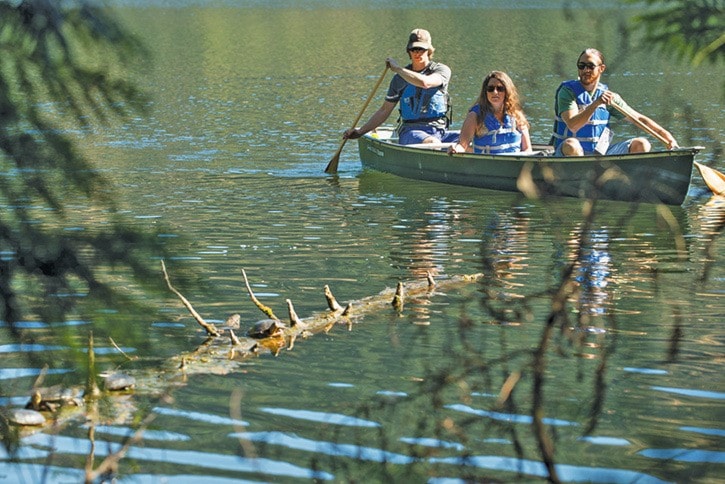Local turtles may have just come one step closer to basking in the sun a little easier
Western painted turtles, like the ones that call Langford Lake home, are an endangered species that one group of Royal Roads University (RRU) students have devoted their time to studying. In fact, these students have spent almost the past year studying these turtles, which happen to have a significant population in and around the Langford lakes systems.
As part of the environmental sciences program at RRU, students are required to bid for and work on a year-long project in the their field. This group, which includes Dan Beckmann, Danielle Spence, Will Kendon, and Grace Brouwer, chose to come up with an environmental sustainability plan, which encompassed all of the work they have done on the project into a roughly 90 page report they presented to Langford’s parks, recreation, culture and beautification committee Monday night. Their focus was on maintaining the population while trying to encourage its growth by creating and enhancing basking and mating sites for the turtles.
“I love turtles,” said Coun. Roger Wade, who vice-chairs the committee, as he waited for the presentation to begin.
Kendon started by asking the committee: “why does protecting turtles matter?” The group proceeded to answer that question by explaining the benefits the turtles have to neighbouring human populations by maintaining the bio-diversity of the area.
“We actually went door to door on the north shore of Langford Lake to see what residents already know,” said Brouwer. She said the group was pleasantly surprised by the reactions they received from residents, many of which could identify the western painted turtles and their invasive cohabiters, the red-ear slider turtle, which is commonly seen in pet stores and has been introduced to the area. While this other turtle doesn’t attack the western painted turtle it often out competes them for habitat and food.
The group identified the creation of nesting sites as a top priority to help encourage the population growth of the western painted turtles.
The current “lack of suitable habitat” was evident with pictures they showed of two turtles trying to build nesting sites in the hard, compacted gravel of the Langford Lake boat launch. Those turtles were unsuccessful in their efforts.
They suggested that nesting sites be created in several areas around the area’s lakes. While some committee members voiced their concerns over the potential size of these areas, the group reassured them that the turtles only needed a small suitable space to nest.
“They’re the size of a loonie when they come out of the nest,” added Beckmann.
They also suggested the city phase in basking logs to help the turtle population. “In terms of basking sites, if you build it, they will come,” said Brouwer.
They identified four potential sites around Langford Lake and one around Glen Lake, after considering factors such as privately owned properties and the amount of sunlight those areas receive. The group added that basking logs will also help determine what the turtle population actually is in the area by making them more visible.
Morry Stearns, a citizen representative appointed to the committee, said he learned a lot from the presentation when the group opened the floor to questions. “One thing that I learned today is to stop pulling up the logs that wash up on my shore. I’ve been using them for firewood,” he said, although he chuckled he would have to find another source of firewood. “I won’t do that any more, I’ll push them back out.”
Wade also had a few questions for the group. “Can you stock these lakes with turtles… Is there a place to go and buy turtles?” He asked, while thinking outside of the box and brainstorming ways to improve the local population.
The group knew of a program in Vancouver that collects eggs in danger, hatches them, and raises the hatchlings to about a year-old before releasing them into their natural habitat.
Wade also suggested a mail-out be sent to lakeshore residents to encourage more awareness on the turtle. The group had originally suggested the city post signs to help educate the community, but, as Wade pointed out, few people actually read those signs, but more people would read mail that directly effects them.
Jane Waters, Langford park planner, urged the committee to read the report in-depth. “The turtles need all the help they can get, there’s a lot of predators.”
She was also excited about the “wealth of knowledge sitting at Royal Roads” that the city could potentially tap into, pointing out that this detailed report was free for the city and could be of great future use.
In that report, the group even recommended future projects that the city could contract out to Royal Roads students.
After the meeting Waters and committee members congratulated the group on their presentation and all of their hard work. The group was optimistic about the impact they could potentially have on future council decisions.
“Hopefully they’ll adopt the recommendations,” said Beckmann.
Kendon said the group was just “championing the report” with their presentation and they had all tried to make the report as informative and easy to read as possible. Spence added they hadn’t realized how much work they had done until they started to compile it.
The group said they had already received lots of positive feedback and support from residents, city staff members, councillors and other organizations.
“Everybody loves the turtles,” added Brouwer.
katie@goldstreamgazette.com
